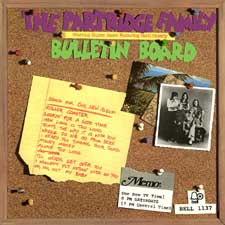
The last studio album for The Partridge Family was released in October of 1973. Musically, it is interesting to see how the Partridge sound evolved from the first record. The music here is groovy and funky, a definite reflection of pop music's embrace of disco. The first cut, Money Money, starts with chompy piano chords. In the chorus, a stray flute fills in the lyrical spaces. The familiar team of Wes Farrell, Danny Janssen and Bobby Hart wrote this one, and it starts the album on an upbeat, rockin' note. Roller Coaster, written by Mark James, takes us up a notch, introducing the clavinet into the Partridge sound bag. Hal Blaine gets to really play some meaty fills in this one. The heated vibe continues with Lookin' For A Good Time, written by Farrell, Janssen and Hart. A suggestive theme for a Partridge Family song, Lookin' For A Good Time begins with an instantly memorable lick. In the chorus, a soulful voice can be heard echoing the title line (Danny, has your voice changed?).
Oh, No, Not My Baby is a classic Gerry Goffin/Carole King tune that has recently been covered by Linda Ronstadt. This arrangement harkens back to more familiar sounding Partridge tunes with one major exception. The electric sitar is used here, as it will later in How Long Is Too Long. Mike Melvoin's string arrangement is subtle and effective without being overbearing. Farrell, Janssen and Hart return once again with I Wouldn't Put Nothing Over On You. This song, which pays an obvious nod to Elton John's Honky Cat, features some tasty piano playing as well as some funky horn lines. Where Do We Go From Here, written by Mark James, is a typical mid-seventies pop tune. Acoustic guitar and percussion gently drive the verses to the funky chorus. The horns and strings provide accents to the melody while a weepy electric guitar hangs in the background. However, the answer to the musical question of the song's title is strangely prophetic.

We set sail into Side Two with the Tom Bahler/Tony Asher tune, How Long Is Too Long. As stated above, the sitar plays a major part in the sound, and thanks to some clever chord changes and sweeping swing lines, the song actually moves. It is interesting to speculate what The Partridge Family would have sounded like had they continued for one or two more albums. We see indications here that the sound would have matured a bit past bubblegum, probably in an attempt to carry over their now maturing original listeners.
Probably the best-known and loved song from the album is I'll Never Get Over You. Tony Romeo's musical sequel to I Think I Love You is every bit the Partridge classic it deserves to be. Romeo's melodic chord inversions, Bahler's "ba-ba" background vocal parts and the string and horn arrangements all swirl together to bring the classic Partridge Family sound alive, perhaps for the last time. Alone Too Long, written by Mark James and Cynthia Weil, slows things down a bit in an attempt at mellow soft rock radio. The song bears all the trademarks of easy listening of the era, but unfortunately comes off sounding quite generic and flavorless.
One of the most melodic and musically satisfying tracks on Bulletin Board is I Heard You Singing Your Song, written by Barry Mann. From verse to chorus to verse to bridge to the end, this song goes through so many musical changes that it creates the illusion of being a much longer song. The choruses, filled with intricately detailed background vocals lift, sway and modulate very dramatically. This is, without a doubt, one of the high points of the record.
The album ends with That's The Way It Is With You, written by Harriet Schoch. The quick yet delicate piano intro sets up the verse and David Cassidy's vocal sounds like it's going through some kind of effects processor. Hal Blaine's distinctive hi-hat playing is spotlighted here. John Bahler's background vocal arrangement serves as a human string section, and the piano playing is quite nimble. Overall, the music on Bulletin Board is quite different from previous Partridge Family efforts. The music scene, as usual, was changing rapidly, and 1973 in particular was a time of refocus and redirection. The album features musicians that had previously not appeared on a Partridge record. It is perhaps unlikely that The Partridge Family could have gone on to the same success experienced only a few years before. As the actors grew older and began to shed their childlike image, the music tastes of the time were growing older, too. The phenomenon of The Partridge Family could best be explained as something that came along at just the right time, providing the perfect kind of entertainment for the audience of the time. And as time moved on, the audience did, too. But The Partridge Family remains unchanged. They're still home, I think, at 698 Sycamore Road. Still rehearsing in the garage. Still gettin' it on and havin' a ball. There's still room on the bus if you want to come on along.
Bulletin Board
Produced by Wes Farrell for Coral Rock Productions, Inc.
Drums: Hal Blaine
Bass: Max Bennett and Jim Hughart
Guitar: Larry Carlton, Richard Bennett, Ben Benay and Dean Parks
Horns: Chuck Findley and Tom Bahler
Trombone: Lou McCreary and George Bohanon
Saxophone: Bill Perkins, Jackie Kelso and Bob Hardaway
Percussion: Gary Coleman and Joe Porcaro
Keyboards: Michael Omartian and Larry Muhoberac
Partridge Family vocals by Shirley Jones and David Cassidy
Background Vocals: John Bahler, Tom Bahler, Jackie Ward and Ron Hicklin
Howard Pattow is the producer and guitarist of Sound Magazine, the Partridge Family Tribute Band.